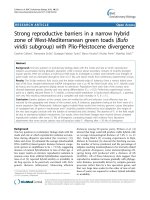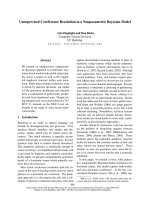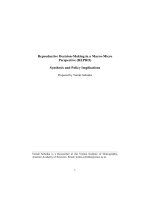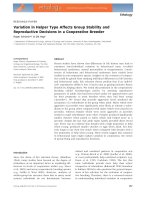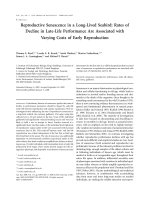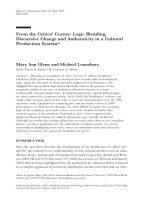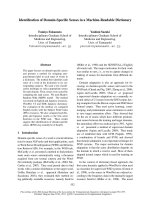Reproductive Decision-Making in a Macro-Micro Perspective (REPRO) potx
Bạn đang xem bản rút gọn của tài liệu. Xem và tải ngay bản đầy đủ của tài liệu tại đây (569.4 KB, 128 trang )
1
Reproductive Decision-Making in a Macro-Micro
Perspective (REPRO)
Synthesis and Policy Implications
Prepared by Tomáš Sobotka
Tomáš Sobotka is a Researcher at the Vienna Institute of Demography,
Austrian Academy of Sciences. Email:
2
European Demographic Research Papers are working papers that deal with
all-European issues or with issues that are important to a large number of
countries. All contributions have received only limited review.
Editor: Maria Rita Testa
Head of the Research Group on Comparative European Demography:
Dimiter Philipov
***
This material may not be reproduced without the written permission of the
authors.
3
Reproductive Decision-Making in a Macro-Micro Perspective
(REPRO): Synthesis and Policy Implications
CONTENTS
1
1 THE REPRO PROJECT: MOTIVATIONS, AIMS, AND MAJOR
ISSUES
5
2 ANALYSING THE IMPACT OF FAMILY POLICIES AND POLICY
‘PACKAGES’
13
3 FERTILITY TRENDS AND REVERSALS: ECONOMIC
DEVELOPMENT AND OTHER INFLUENCES
20
3.1 Cross-country differences in low fertility 20
3.2 Economic development and fertility 24
3.3 Changing family-related norms 27
3.4 Costs of children: housing market and opportunity costs 28
4 POLICY INFLUENCES ON FERTILITY: A review
33
5 FORMATION OF FERTILITY INTENTIONS
39
5.1 Intention formation: The Theory of Planned Behaviour framework 40
5.2 Data and countries 41
5.3 Believes, attitudes, perceived norms and perceived control 41
5.4 Forming an intention to have a child 42
5.5 The analysis of short-term and medium-term intentions 44
5.6 Couples’ fertility intention: An analysis using the theory of planned
behaviour
45
5.7 Aggregate-level context and policy implications 48
1
Most of these sections are based on papers, reports, deliverables and other
materials prepared within the framework of the REPRO project. Authors of these
materials are listed below the title of each section where appropriate and the most
relevant documents are listed in a footnote on the first page of each section.
4
6 FROM INTENTIONS TO BEHAVIOUR
50
6.1 Intentions and subsequent behaviour: realisation, postponement, and
abandonment
50
6.2 Cross-country differences in birth intentions realisation 54
6.3 Determinants of successful realisation of fertility intentions 56
6.4 Changes in fertility intentions across the life course 59
6.5 Realisation of fertility intentions in Hungary and Bulgaria 64
6.6 Economic uncertainty and fertility intentions, timing and level 67
7 FERTILITY CULTURES IN EUROPE
70
7.1 The emergence of a culture of childlessness 71
7.2 Changing gender roles and fertility decisions 74
7.3 When values do not fit practices: the uneven advance of social change 77
7.4 A typology of declared fertility intentions 80
7.5 Changing intentions and behavioural outcome over time 84
8 THE MACRO-MICRO LINK: FERTILITY DECISIOMAKING IN
CONTEXT
88
8.1 Perceived norms concerning fertility-related behaviour: Cross-national
differences
89
8.2 Child number and child timing intentions 96
8.3 The effect of educational attainment on fertility tempo and quantum in
Europe
100
9 CONCLUSIONS
102
APPENDIX
106
Appendix 1: A summary of recent cross-national studies on the effects of
family policies on fertility
120
Appendix 2: The social psychology of intention formation 123
Appendix 3: 128
5
1
THE REPRO PROJECT: MOTIVATIONS, AIMS AND MAJOR
ISSUES
Population discussions in contemporary Europe are often dominated
by the notions of very low fertility rates and inevitable future population
decline, which germinated during the period of rapid fertility declines in
western Europe in the 1970s and early 1980s. Already in 1984, the European
Parliament passed a resolution (No. C127/78) that called for a consideration
of “measures to combat this marked trend towards population decline, which
is common to all the Member States”. (PDR 1984).
2
The intertwined fears of
low fertility and decreasing population are closely related to yet another pair
of stylised facts: first, women and men across Europe wish to have more
children than they actually achieve by the end of their reproductive lives.
Second, this ‘gap’ between intentions and actual behaviour leaves plenty of
scope for effective policy action. Such policies would help eliminating some
of the obstacles that prevent individuals from having the desired number of
children, addressing structural and institutional constraints which are
frequently perceived as rationales for policy action (Chesnais 2000;
McDonald 2006). The official communication from the European
Commission (2005: 5) fully embraces this view, pointing out that the fertility
rate in Europe is “insufficient to replace population” and that this low
fertility “is the result of obstacles to private choices: late access to
employment, job instability, expensive housing and lack of incentives
(family benefits, parental leave, child care, equal pay)“. In a more dramatic
way, the document considered low birth rates “a challenge for the public
authorities“. Similar concerns have been expressed in a resolution of the
2
At present (as of January 2011), the official website of the European Parliament
features a section on population-related issues with suggestive titles, including a
caption below a photo of a baby reading “What’s the answer to Europe’s
demographic deficit?” (see
/>PRESS&reference=20080414FCS26499&language=EN#title1).
6
European Parliament on the demographic future of Europe in 2008
(European Parliament 2008).
Policies may also influence fertility behaviour—indirectly by
affecting people’s childbearing norms, desires and intentions, or directly by
either creating a structure of incentives that would be sizeable enough to
increase fertility rates irrespective of people’s initial preferences or, most
controversially, by deliberately intervening into individuals’ decisions, e.g.
by restricting access to abortion. The latter option is clearly unacceptable in
most democratic societies but also the ‘softer’ influences on intentions or
direct efforts to stimulate fertility rates by enacting economic or other
incentives are potentially problematic. It is not clear whether governments of
democratic countries should deliberately intervene to influence individuals’
private decisions about family size and reproduction, without even having a
clear idea about what a socially desired or optimal fertility should be and
whether such policies would improve the quality of life and wellbeing of the
citizens (van de Kaa 2006).
3
In contrast, policies that would help people
realise their unfulfilled ‘demand’ for children appear to be a win-win
strategy, presumably increasing the happiness of the prospective parents and
at the same time helping to increase fertility rates in a country without
interfering with individual preferences.
The stylised facts and assumptions about fertility and population
challenges are not necessarily wrong but they provide a crude and potentially
misleading simplification of the complex picture of reproductive decision-
making, fertility rates and the role of family-related policies in Europe. The
need for a careful and evidence-based research on fertility intentions and
fertility behaviour motivated the launching of the REPRO project
3
While the most commonly considered ‘optimal’ level of fertility is a population
replacement level (which is around 2.07 children per woman in the most developed
countries), Lutz and Striessnig (2010) argue that with a high share of university-
educated population and a related rapid rise in productivity the optimal fertility may
be well below 2 children per woman.
7
(Reproductive decision-making in a macro-micro perspective) that had as its
main aim to “fill gaps in knowledge on the factors which drive changes in
fertility rates and generate new scientific and policy-oriented knowledge on
the reproductive decision-making of contemporary Europeans”. The project,
concluded in January 2011, has linked together researchers from nine
European research institutions and with different disciplinary backgrounds.
4
REPRO saw fertility intentions as a main component of the reproductive
decision-making process. As a coherent unifying framework it applied the
social psychological theory of planned behaviour (TPB, Ajzen 1991, 2005),
developed as an extension to the theory of reasoned action (Fishbein and
Ajzen 1975). The TPB has been used in thousands of studies aiming to
explain which factors influence the formation of intentions to engage in
certain behaviours and which factors in turn determine whether these
intentions are acted upon. Applying the TPB to childbearing intentions has
vastly expanded our understanding of the formation of fertility intentions, of
the importance of determinants of these intentions and, in turn, of the link
between intentions and their realisation or non-realisation (or
‘abandonment,’ as Spéder and Kapitány’s (2010) REPRO study calls it).
4
The following institutions participated in the project: (1) Vienna Institute of
Demography (VID) at the Austrian Academy of Sciences as the leading institution;
(2) Institut national d’études démographiques (INED, Paris); (3) Netherlands
Interdisciplinary Demographic Institute (NIDI, The Hague, the Netherlands); (4)
“Carlo F. Dondena” Centre for Research on Social Dynamics at the Università
Bocconi, Milan, Italy; (5) The Demographic Research Institute (DRI) from
Budapest, Hungary; (6) Division for Social and Demographic Research at the
Statistics Norway, Oslo (SSB); (7) Co-ordination Research Council for Social
Development and Social Eurointegration from the Bulgarian Academy of Sciences,
Sofia (BAS-RCSD); (8) Institute for Social and Economic Research at the Essex
University (UESSEX); and (9) University of Lausanne (UNIL, Switzerland). This
last institution conducted research started at the Max Planck Institute for
Demographic research in Rostock, Germany.
8
The REPRO project placed emphasis on studying fertility decisions
at an individual (micro) level. However, it also aimed at integrating different
levels of analysis, which are important for understanding fertility behaviour.
Specifically, fertility intentions and behaviour were studied at three levels:
(1) the aggregate (macro) level, where social, cultural, economic, or
institutional conditions are related to aggregate-level outcomes (fertility
norms, intentions and fertility rates); (2) the individual (micro) level,
studying fertility decision-making process, its determinants and outcomes at
the level of individual men, women and couples; and (3) the macro-micro
level, where individual behaviour is conditioned by both individual-level
factors such as age, number of children, employment situation or education,
as well as institutional conditions of a given country or region. The analysis
of numerous national and cross-national datasets was complemented with
qualitative studies on the reproductive decision-making process using in-
depth interviews conducted in cities in seven European countries. Among
various datasets used, the Generations and Gender Survey, conducted in
numerous European countries (eight of which were included in REPRO),
was particularly relevant for the REPRO work as it contained questions on
intentions formulated using the theory of planned behaviour (Vikat et al.
2007: 420). The TPB sets rigorous standards for the definition and
measurement of intentions. In the case of childbearing, intentions have to be
specified by current parity (number of children) of the respondent, and
ideally they have to be formulated for a specific time horizon, so that their
realisation can be later analysed. Moreover, the certainty and ambiguity of
intentions have to be explicitly measured. This is easier achieved when
intentions refer to a short time interval, for which respondents have a clearer
picture of their likely partnership status and economic situation and when
there are fewer external factors that might cause a revision of their intention.
For this reason, REPRO has primarily focused on studying short- to mid-
term intentions, typically referring to the next three years, rather than
lifetime reproductive plans.
9
In a nutshell, the key facets of the REPRO project can be summarised as
follows:
Multidisciplinary and multi-team work;
Focused on the elements of the fertility decision-making process,
especially on the formation of intentions, their realisation and the
factors affecting them;
Theory-driven, using theory of planned behaviour (TPB) as an
overarching framework linking different disciplinary perspectives;
Taking individual-level decisions and behaviour as paramount;
Linking individual and aggregate-level analyses;
Studying contextual influences by applying a comparative cross-
country framework;
Using qualitative analysis of narrative data as an essential
component;
Employing a variety of datasets, especially longitudinal panel data
suited for the TPB framework; and
Addressing policy-relevant issues
REPRO work has been organised alongside eight work packages.
While the first one focused on project management and the last two dealt
with synthesising and disseminating the results, five work packages
concentrated on conducting the research along the following topics:
Work package 2 (WP2, leader Olivier Thévenon, INED): The macro level:
changes in birth rates;
Work package 3 (WP3, leader: Jane Klobas): Contextualised micro level:
fertility intentions;
Work package 4 (WP4, leader: Zsolt Spéder): Contextualised micro level:
fertility behaviour;
Work package 5 (WP5, leader: Laura Bernardi): Fertility intentions and
behaviours in context: a comparative qualitative approach;
Work package 6 (WP6, leader Aart C. Liefbroer): The macro-micro-
conditions of intentions and births.
10
This summary document draws extensively from the numerous
project deliverables, papers, articles and documents prepared within these
five work packages. When citing documents and deliverables summarising
the work package work and prepared by the work package leaders,
frequently only the work package is listed. Specific materials prepared by
individual researchers are cited separately. To prevent this document from
becoming excessively voluminous, many details, results and important
insights have been omitted. For further details, readers are referred to the
deliverables and other useful documents from individual work packages that
can be accessed at the REPRO website
(www.oeaw.ac.at/vid/repro/documents.html).
The goal of this review is to communicate major findings and
achievements and summarise policy-relevant findings of the REPRO project.
The analysis of policies belonged to the main objectives of REPRO. The
research teams aimed to identify “the implications of the findings for policy
strategies which attempt to enhance individuals’ and couples’ freedom of
choice with regard to fertility-related behaviours”. The underlying
assumption is that policy-relevant analysis should greatly benefit from the
project’s explicit focus on the components of reproductive decision-making,
and fertility intentions in particular. Selected major findings have been
highlighted in two ‘Policy briefs’.
5
However, a number of factors, which are
elaborated in Section 2, make specific policy inferences and policy
recommendations rather difficult. In short, there is a vast array of policies
potentially affecting reproductive behaviours which frequently change,
supplement or contradict each other, operate in different cultural contexts
and may affect particular social and demographic groups in the population in
different ways. In addition, policies may have short-term or long-term
effects and may affect both the timing of reproduction and the number of
children born. It is also important to keep in mind that a vast majority of
social policies affecting reproductive decisions were designed with a
5
Accessible at
11
different purpose and their potential fertility effects were not an important
consideration in their implementation. For these reasons, our policy
conclusions, summarised in Section 9, are rather general and cautiously
formulated. REPRO findings have shown that the most important avenues
for potential policy intervention include job insecurity, gender equality and
the reconciliation of work and family.
Structure of this report and the work packages covered
This document mostly follows the structure of individual work packages
and reviews the main findings and policy implications based on various
reports, papers and deliverables prepared within REPRO, as well as
additional policy conclusions supplied by the leaders of work packages 2-
6. It is remarkable that although each work package primarily operates at
a different level of analysis—micro, macro, or a combination of both
levels—each WP analysed datasets for several countries and therefore
addressed the impact of societal context. Other than the majority of
previous studies, most REPRO work packages also studied fertility
intentions and fertility among men, bringing the frequently ‘ignored half’
of the population into the spotlight. Given the prominence of policy-
relevant analysis within REPRO, most sections of this report are
complemented with a brief summary of policy inferences mostly
formulated by the work package leaders.
The following three sections (Sections 2-4) are framed around the
WP2 and give the aggregate (macro-level) view on fertility and policies in
Europe. These parts also give a general introduction to some of the key
issues discussed in REPRO: the issue of low fertility in Europe and the
differences in family policies across Europe as well as policy influences
on fertility rates. Specifically, Section 2 gives a general overview of
various types of family-related policies, differences in European welfare
states and family policy ‘packages’, and lists some important general
(continued on the next page)
12
Structure of this report and the work packages covered (continued)
considerations that need to be taken into account in policy-relevant
analysis. Section 3 highlights cross-country differences in low fertility in
contemporary Europe and shows the results of WP2 research on the link
between economic development and fertility and on the effects of the cost
of children. Section 4 reviews the multifaceted effects of family policies
on fertility, mostly based on WP2 results.
In contrast, Section 5, based on WP3, gives the ‘micro’ picture of
the factors influencing the formation of fertility intentions. This section
also gives a brief introduction to the Theory of Planned Behaviour (TPB)
which has motivated most of REPRO research and linked different work
packages together (see a summary of the TPB in Appendix 2). Because
WP3 studied fertility intentions in different countries, it also provided
comparative aggregate-level conclusions on the factors driving cross-
country differences in the formation of intentions (Section 5.7).
Section 6 covers mostly WP4 research that examines the factors
influencing the realisation of short-term (within three years) reproductive
intentions as well as the development of intentions across the life course.
Again, by analysing datasets for different contexts, WP4 also discusses
some determinants of between-country differences in the share of
individuals that were able to realise their intentions (Section 6.2).
Section 7 summarises findings of WP5, which provided
qualitative interpretative data analyses of respondents in seven European
countries focusing on perceived reproductive norms, gender relations and
fertility intentions, as well as on the typology of intentions and their
changes. This section provides a narrative framework to the ‘larger
picture’ analysed in the other parts of REPRO and thus greatly contributes
to the understanding of intentions formation and realisation.
Section 8, reviewing WP6 work, then connects the ‘micro’ and
‘macro’ pictures by analysing multi-country European surveys, looking at
the individual and country variations in fertility norms, fertility intentions
and the influence of education on completed family size.
13
2
ANALYSING THE IMPACT OF FAMILY POLICIES AND POLICY
‘PACKAGES’
(mostly based on WP 2, coordinated by Olivier
Thévenon)
6
One of the main goals of this document is to assess implications of
family-related policies that are in place in different countries of Europe. This
seemingly straightforward goal is in effect a particularly complex and
difficult undertaking. First of all, many policies influencing family and
reproductive behaviours have a wide variety of objectives, such as reducing
income inequality and poverty, promoting gender equality, promoting
female employment or supporting child development (OECD 2007). Most of
them were not enacted with an explicit or implicit aim to influence
individual reproductive behaviours, and their success or failure should not be
judged by their fertility effects. Furthermore, policies may affect various
social groups of men and women in different ways with respect to their age,
number of children, educational attainment, employment status, or
partnership status. Under certain circumstances, policies may increase
fertility, but at the same time have an undesired effect of strengthening the
polarisation of reproductive behaviour between groups (WP2, McLanahan
2004). Therefore, findings on the influences of policies at an individual level
may not be easily translated into statements about the aggregate impact of
policies on fertility rates in a country. Overall, financial support for families
has a major impact on the direct and indirect cost of children, but its impact
on fertility seems limited. While there is a clear influence on the timing of
births, the impact on fertility is often short-lived and the policy influence of
completed cohort fertility is often debatable (Sleebos 2003; Gauthier 2007;
Thévenon and Gauthier 2011). This debate is further complicated by the fact
that it is frequently impossible to disentangle the effects specific policies
6
Thévenon, O. 2011, “Family policies in OECD countries : a comparative analysis.”
Population and Development Review 37(1): 57-87. OECD. 2011. “Fertility trends:
what have been the main drivers?” Chapter 3 in: Doing Better for Families, OECD,
Paris. Thévenon, O. and A. Gauthier. 2011. “Family policies in developed countries:
a ‘fertility-booster’ with side-effects.” Forthcoming in Community, Work and
Family.
14
may have on fertility in the absence of long-term information on policy
changes and mutual interactions between different policies. Finally, there is
usually no evidence concerning the ‘counterfactual’ situation, i.e. what
would the observed fertility trend be in the absence of given policy measures
(Hoem 2008).
There is a bewildering diversity of potentially relevant policies in
Europe that may have an influence on reproductive decisions. Roughly, they
can be divided into five categories (WP2, see also OECD 2007):
Policies that support mothers-to-be during pregnancy until
delivery;
Support for childbirth, e.g. a baby kit, vouchers, or a lump sum
paid upon the birth of a child (‘baby bonus’);
More regular, long-term financial assistance for families to cover
the direct cost of children. This comes in various forms, such as
family allowance, welfare benefits dependent on the number of
children, tax breaks for families with children, or support to cover
some education expenses;
Support designed to help parents balance working and raising
children. This category encompasses especially child care and
education facilities, work arrangements such as flexible working
time and part-time work availability; as well as financial benefits
and tax breaks linked to employment;
Entitlements to paid or unpaid parental leaves for parents who are
not in paid employment or who stop working to care for young
children.
To put it simply, these policies can be divided into monetary
transfers (e.g. ‘baby bonus’, or tax breaks for parents), leave provisions
(especially maternity or parental leave, but also short-term leave possibilities
for parents with sick children) and infrastructure provisions (in particular
child care facilities). In addition, the provision of health and education and
their quality and costs may influence reproductive decisions.
15
Individual policies, their changes and their influences can be studied
using various research designs, but it is the package of different policies,
their internal consistency, coherence and compatibility, as well as their
stability over time which matters most for reproductive decisions (Thévenon
and Gauthier 2011). As Neyer and Andersson (2008: 702) point out,
“policies may counteract each other by having different aims or
requirements, or they may reinforce each other by being based on the same
underlying logic“. However, such combinations are particularly difficult to
analyse, not least because data on such aspects are frequently not available
(Gauthier 2007).
The idea of dividing sets of countries into groups with differentiated
mix of ‘policy packages’ and institutional approaches to families and social
stratification was popularised by a 1990 study of western European welfare
regimes by Esping-Andersen. One of the main criteria for distinguishing
different welfare regimes was the extent of decommodification (Esping-
Andersen 1990), a process, through which welfare state reduces individual’s
reliance on market forces or wider family support for their well-being. Later,
other country groupings by different policy criteria have been developed,
usually based on the distinction between policies favouring homecare by
parents and policies favouring institutional child care on the one hand, and
between different levels of financial support by governments and the
structure of the labour market with respect to favouring mothers’ return to
employment (e.g. Kontula and Söderling 2008), on the other. Alternatively,
geographical groupings of countries with relatively consistent policy
packages was used (Gauthier and Philipov 2008).
Within REPRO, WP2 used the OECD Family database
7
to map
cross-country differences in family policy models and update the existing
country classification. The quantitative indicators in this database give a
much more detailed set of policy characteristics than those used in previous
7
Accessible at
<www.oecd.org/document/4/0,3343,en_2649_34819_37836996_1_1_1_1,00.html>.
16
studies, enriching the comparisons that can be made. A principal component
analysis was performed to characterise how the components of family
support are combined and how different countries are located with regard to
these ‘packages’. The results support the view of persistent differences in the
family policy patterns embedded in different contexts of work-family
outcomes. Previous groupings of policy regimes are only partially
corroborated, owing to considerable within-group heterogeneity and the
presence of group outliers. Four main groups of OECD
8
countries were
identified (Thévenon 2011; see the position of individual countries plotted in
Figure 1:
1. The Nordic countries (Denmark, Finland, Iceland, Norway and
Sweden) stand out for their comprehensive support to working
parents with very young children (under 3 years of age);
2. Anglo-Saxon countries (Australia, Canada, Ireland, New Zealand,
United Kingdom and the United States) where support for working
parents with very young children is less comprehensive and
spending is higher for older children. In these countries, financial
support is also more clearly targeted on low-income and/or large
families;
3. A mix of countries from eastern and southern Europe plus, outside
Europe, Japan and Korea, where the degree of support is lower,
whichever type is considered;
4. Other European countries form a less homogeneous group with a
more intermediate position.
8
OECD, Organisation for Economic Cooperation and Development, has 34 member
states, of which 24 are in Europe. It includes mostly the rich societies, although a
few countries, including Chile, Mexico, and Turkey, can be defined as middle-
income countries. The organisation’s official aim is “to help governments foster
prosperity and fight poverty through economic growth and financial stability,” and
to this goal it collects and publishes a vast amount of data, including information on
family policies that have been extensively processed in WP2.
17
Furthermore, WP2 investigated heterogeneity of these groups, identifying
many country-specific patterns (Figure 1). Much longer parental leave times
in Finland and Norway and lower child care enrolment rates for children
below age 3 differentiated them from the other three Nordic countries. UK
and New Zealand are set apart from the other Anglo-Saxon countries by
higher public spending per child under age three enrolled in child care, as
well as on education services. Hungary differed from the other countries in
Group 3 in that it provides much more comprehensive support to parents
with young children, especially with regard to higher parental leave
payments. WP 2 also investigated the three salient contextual dimensions
related to key objectives of family policies: poverty, fertility and labour
market position of families (which includes a dimension of gender equity).
Considering country groupings by policy regime is important for
other reasons than classifying existing policy sets and analysing their
changes over time. Existing policies were not established in a vacuum,
rather, they were shaped by cultural traditions and prevailing societal norms
in a given country and in turn shaped these traditions and norms. It is
important to consider whether a particular policy measure lagged behind the
broader social change or, in contrast, acted as a forerunner or even a ‘trigger’
of some behavioural and value changes (Neyer and Andersson 2008).
Policies that have a certain effect in one welfare context may not operate in
the same way in another one. For instance, offering cheap and high-quality
institutional child care for children below the age of three may stimulate
higher work participation of mothers and increase their subsequent fertility
in countries and among social groups where the prevailing norms accept
their labour participation when children are small, but the same measure may
fail to have much effect in settings where the prevailing norms stipulate that
mothers should stay at home when their children are small (see also WP5
work reported in Section 7.3 and WP6 work in Section 8.1).
18
Figure 1 Typology of OECD countries by family policies
Source: WP2: Thévenon 2011 ( “Family policies in OECD countries: A
comparative analysis.” Population and Development Review 37(1): 57-87).
19
Important factors in policy-relevant analyses
Summing up the issues discussed in this and the previous section, the
following general factors, which may hinder the reaching of clear-cut
conclusions about policy effects on reproductive decision-making, should
be considered in policy-relevant analyses:
Many different policies simultaneously affect fertility decisions;
Most of these policies are not aimed at influencing fertility but
motivated by different objectives;
Policies may be analysed one by one, but it is the combination of
policies and their coherence or their conflicting influences that
matters for reproductive decisions;
Stability is an important policy feature, improving the
predictability of the consequences of individual reproductive
decisions;
The fertility impact of policies may differ widely by social group,
by age and by the number of children already born;
Also the institutional context, including prevailing norms and
attitudes in a country, matters for the way how a particular policy
may be accepted and how will it influence reproductive decisions;
It is important to distinguish short-term and long-term policy
effects as well as their influences on the timing and level of
fertility;
Well-designed policies signal that having and rearing children is
important and valued, and that parents will be supported in their
endeavour.
In REPRO, the analysis of policy packages, discussed further in
Section 4, was limited by a lack of information on specific policies and their
changes over time in many OECD countries. Future research should in
particular address the question of how different work-family reconciliation
policies are linked to welfare state regimes. A more detailed analysis of the
20
rapidly changing policy environment in the former state-socialist countries
of central and eastern Europe constitutes another high-priority issue on the
future research agenda.
3
FERTILITY TRENDS AND REVERSALS: ECONOMIC
DEVELOPMENT AND OTHER INFLUENCES
(Based mostly on WP2 results, coordinated by Olivier Thévenon)
9
3.1 Cross-country differences in low fertility
It has almost become a cliché, repeated in dozens of documents over
the last three decades, that European countries have low and declining
fertility rates. Recent evidence as well as the research conducted by REPRO
(WP2) paints a somewhat different picture of fertility developments. By any
measure, most European countries do have low fertility rates, and some
western European countries—most notably Germany—have experienced
low or very low fertility since the 1970s. However, period fertility,
especially the period Total Fertility Rate (TFR), declined to very low levels
in part due to the postponement of childbearing, i.e. a continuing long-term
shift towards later childbearing ages, which has negatively affected period
fertility rates (Kohler et al. 2002; Sobotka 2004). Meanwhile, completed
cohort fertility rates, which are not affected by this effect of childbearing
postponement, have also declined in most countries but remained well above
the level of the period fertility rates (Figure 2). Whereas only six out of 33
European countries with populations over 1 million had period total fertility
rates (TFR) above 1.7 in 1998, as many as 24 recorded a completed fertility
rate above 1.7 among the women who were in their prime childbearing years
at that period, specifically, the cohort born in 1968.
9
Luci, A., and O. Thévenon. 2011 “Does economic development drive the fertility
rebound in OECD countries?” Working Paper /Document de travail, INED n°167.
«
OECD. 2011. “Fertility trends: what have been the main drivers?” Chapter 3 in:
Doing Better for Families, OECD, Paris.
21
Figure 2 Distribution of European countries by their period and cohort
fertility levels: Period TFR in 1998 and 2008 and completed cohort fertility
of women born in 1968
0
2
4
6
8
10
12
14
16
18
20
Below 1.3 1.3-1.49 1.5-1.69 1.7-1.89 1.90+
Total fertility rate
Number of countries
Cohort TFR, BC 1968
Period TFR, 1998
Period TFR, 2008
Data sources: Eurostat (2010), VID-IIASA (2010) and Council of Europe (2006)
Notes: Only countries with population over 1 million are included. Turkey, as well
as three countries with nonexistent or unreliable data (Albania, Bosnia and
Herzegovina and Kosovo) are excluded.
In addition, mostly as a consequence of the ‘recovery’ of postponed
childbearing among women of higher childbearing ages, period fertility rates
increased in most of the developed countries in 1998-2008, leading to a
reversal of the longstanding trend of declining fertility rates (Goldstein et al.
2009). WP2 illustrated this reversal with an example of the OECD countries,
which experienced, with a few exceptions (Luxembourg, the Nordic
countries of Europe except Finland and the United States), considerable
declines in the period TFR between 1980 and 1995. However, in the
subsequent period of 1995-2008, 19 out of 25 European OECD countries
recorded an increase in their period TFR. As of 2008, many countries of
22
northern and western Europe, including France and the United Kingdom had
higher period fertility rates than in the mid-1980s, indicating that the notion
of a continuing European-wide fertility decline is no longer valid.
Low fertility in Europe is strongly differentiated by region (WP2,
Frejka and Sobotka 2008). A ‘higher-fertility’ area of Europe, with both
period and cohort fertility rates between 1.7 and 2.2 births per woman,
includes the United Kingdom, France, Ireland, Belgium, Luxembourg, the
Netherlands, and all the Nordic countries, whereas the German-speaking
countries, southern Europe and central and eastern Europe (with a few
exceptions, such as Albania, Kosovo, Macedonia and Montenegro) have
lower fertility rates (Figure 3). Considerable differences in fertility rates
among the most developed countries prevail outside Europe as well:
Australia, the United States and New Zealand have fertility rates at or
slightly above 2 births per woman, comparable to the highest-fertility
countries in Europe, whereas the rich countries of East Asia—Japan, Korea
and Taiwan—have fertility levels close to the lowest-fertility countries of
Europe (see Figure 3 for Japan and the United States).
The new differences in fertility levels between the most affluent
countries of Europe, for instance between Germany with a low cohort
fertility just below 1.5 births per woman and neighbouring France with a
cohort fertility around 2 births per woman is indicative of cultural and policy
influences that are worth analysing in detail. In this document, we
concentrate especially on the role of seven broader sets of factors: economic
development (e.g. Sections 3.2 and 8.2), changing family-related norms (e.g.
Sections 3.3, 5, 7.1, 8.1 and 8.2), changing gender norms, attitudes and
practices (Sections 6.6, 7.2 and 8.1), changing costs of children (including
housing costs that play an important role; Sections 3.4, 5.2 and 5.3), policy
influences (Sections 2, 4, 5.7 and 8.1), economic uncertainty, especially
unemployment (Section 6.6), and the rapid pace of structural changes in
society (Sections 6.2 and 7.3). Many other factors have been discussed in the
literature, including compositional effects of populations with respect to
higher-fertility migrants and ethnic minorities as well as religiosity (Sobotka
23
2008; McDonald 2010), and social status polarisation in fertility in countries
like the United Kingdom and the United States, where many less educated
and socially disadvantaged women show a high and early fertility pattern.
Figure 3 Period total fertility rate in the larger regions of Europe as
compared to Japan and the United States, 1985-2008
1.00
1.20
1.40
1.60
1.80
2.00
2.20
1985 1990 1995 2000 2005 2010
Period TFR
Central Europe Eastern Europe South-eastern Europe
Western Europe German-speaking c. Southern Europe
Northern Europe United States Japan
Data sources: Eurostat (2010), VID-IIASA (2010) and Council of Europe (2006),
national data sources.
Notes: Data are weighted by the population size of countries within a given region.
Regional division: Central Europe: Croatia, Czech Republic, Estonia, Hungary,
Latvia, Lithuania, Poland, Slovakia, Slovenia;
South-eastern Europe: Bulgaria, Macedonia, Montenegro, Romania, Serbia;
Eastern Europe: Belarus, Moldova, Russia, Ukraine;
Western Europe: Belgium, France, Ireland, Luxembourg, the Netherlands, United
Kingdom;
German-speaking countries: Austria, Germany, Switzerland.
Southern Europe: Italy, Greece, Portugal, Spain;
Northern Europe: Denmark, Finland, Norway, Sweden.
24
3.2 Economic development and fertility
(Based mostly on WP2 work by Angela Luci and Olivier Thévenon
(2010))
10
Throughout most of the 20th century, economic development was
strongly and negatively correlated with fertility at a national level. A new
and widely discussed area of research focuses on the possibility that this
relationship has reversed and therefore countries that surpass a certain level
of affluence will achieve higher fertility rates. A widely publicised paper by
Myrskylä, Kohler and Billari (2009) supported this hypothesis, using the
Human Development Index (HDI) constructed by the United Nations.
Within REPRO, WP2 conducted an extensive analysis of the
relationship between period fertility rates and GDP level in the OECD
countries over time, looking at the period of 1960-2006 (see the detailed
account by Luci and Thévenon 2010). As expected, economic
development—as captured by an increase in GDP per capita—has a negative
impact on period fertility rates when country GDP level is relatively low.
However, once societies attain a certain level of economic development, the
relationship reverses and economic growth is associated with increased
fertility rate. Figure 4, based on Luci and Thévenon (2010), illustrates this
inversed-J shaped relationship. The line represents the estimated path linking
the total fertility rate to income per capita (logarithmic scale) in 1960-2006.
A fixed-effects model is applied to capture the time trend and to control for
country effects. In the absence of strong country-specific characteristics,
countries are expected to be located close to the predicted line. The turning
point for the fertility trend is estimated at the value of GDP per capita around
32,600 US Dollars ($, values are computed in purchasing power parity)
when the estimated fertility curve reaches its minimum. This GDP threshold
10
Luci A., and O. Thévenon. 2011 “Does economic development drive the fertility
rebound in OECD countries?” Working Paper /Document de travail, INED n°167.
«
OECD. 2011. “Fertility trends: what have been the main drivers?” Chapter 3 in:
Doing Better for Families, OECD, Paris.
25
is higher than the actual OECD average, currently at around 28,000 US$.
This threshold also corresponds to a minimum of period total fertility rate at
1.51 children per woman, which is in effect higher than the actual fertility
level in many low-fertility countries, and higher than the lowest fertility
value achieved in most European countries in the past 20 years.
Clearly, fertility trajectories in individual countries often deviate
from the predicted pattern, which is also apparent from a comparison of
country locations in Figure 4, corresponding to their 2006 levels of GDP and
period TFR. Thus, the model should be understood as a simplified
representation of reality, where other factors, including family policies, may
strongly modify the relationship between economic affluence and fertility
(see below). However, the main finding about the reversal of the fertility
trend at higher GDP levels is robust and has been supported also when other
model specifications have been formulated.
A decomposition of GDP into different components shows that
fertility rates co-vary with the increase in female employment rates. This
clearly indicates that the increase in GDP per capita at high levels of
development actually captures a qualitative change in the organisation of
employment and family life. In that context, most of the effect attributed to
an increase in economic development actually captures increasing
opportunities for women to combine family life employment. Economic
advancement in most of the richest countries therefore increases women’s
labour market opportunities and at the same time has a positive impact on
reconciliation possibilities for parents.
These findings lead to the following main conclusions:
At high GDP levels, further economic development is likely to
stimulate an increase of fertility rates;
Steeper increases in fertility are observed in countries where the
opportunities for women to participate in the labour market and
to combine work with family have increased.
